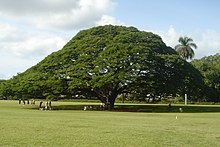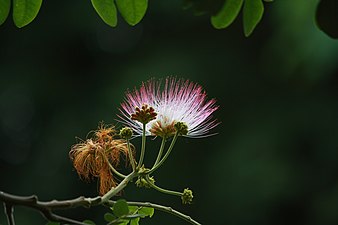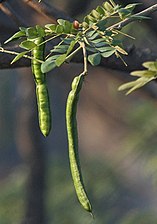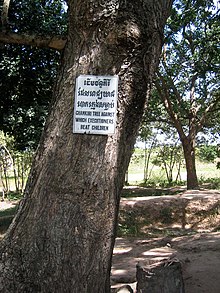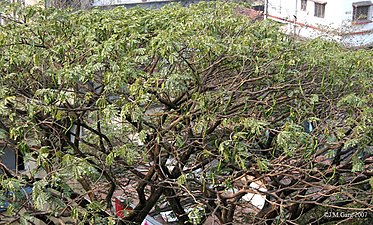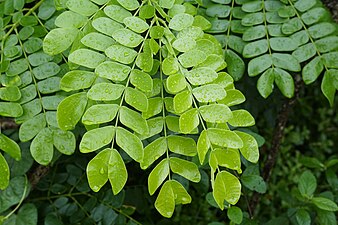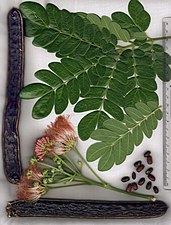
Friedrich Wilhelm Heinrich Alexander von Humboldt was a German polymath, geographer, naturalist, explorer, and proponent of Romantic philosophy and science. He was the younger brother of the Prussian minister, philosopher, and linguist Wilhelm von Humboldt (1767–1835). Humboldt's quantitative work on botanical geography laid the foundation for the field of biogeography, while his advocacy of long-term systematic geophysical measurement pioneered modern geomagnetic and meteorological monitoring.

Aimé Jacques Alexandre Bonpland was a French explorer and botanist who traveled with Alexander von Humboldt in Latin America from 1799 to 1804. He co-authored volumes of the scientific results of their expedition.

Albizia is a genus of more than 160 species of mostly fast-growing subtropical and tropical trees and shrubs in the subfamily Mimosoideae of the family Fabaceae. The genus is pantropical, occurring in Asia, Africa, Madagascar, America and Australia, but mostly in the Old World tropics. In some locations, some species are considered weeds.

Enterolobium cyclocarpum, commonly known as conacaste, guanacaste, caro caro, devil's ear tree, monkey-ear tree, or elephant-ear tree, is a species of flowering tree in the family Fabaceae, that is native to tropical regions of the Americas, from central Mexico south to northern Brazil (Roraima) and Venezuela. It is known for its large proportions, expansive, often spherical crown, and curiously shaped seedpods. The abundance of this tree, especially in Guanacaste Province, Costa Rica, where it is prized for the shady relief it provides from the intense sun, coupled with its immensity, have made it a widely recognized species. It is the national tree of Costa Rica.

Albizia julibrissin, the Persian silk tree, pink silk tree, or mimosa tree, is a species of tree in the family Fabaceae, native to southwestern Asia and eastern Asia.

The Jardin de l'État, formerly known as the Jardin du Roy, is a historic botanical garden on the island of Réunion, found in the capital Saint-Denis.
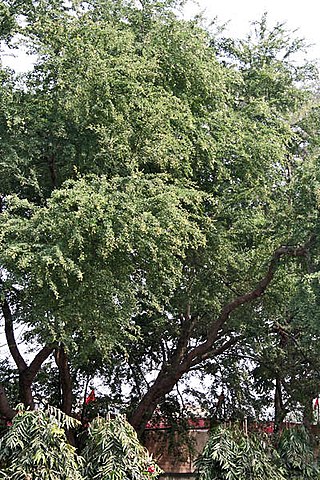
Pithecellobium dulce, commonly known as Manila tamarind, Madras thorn, monkeypod tree or camachile, is a species of flowering plant in the pea family, Fabaceae, that is native to the Pacific Coast and adjacent highlands of Mexico, Central America, and northern South America. It is also sometimes known as monkeypod, but that name is also used for several other plants, including Samanea saman. It is an introduced species and extensively naturalized in the Caribbean and Florida, as well as the Philippines and Guam via the Manila galleons. It has also been introduced to Cambodia, Thailand and South Asia, It is considered an invasive species in Hawaii.

Spondias dulcis, known commonly as June plum, is a tropical tree, with edible fruit containing a fibrous pit. In the English-speaking Caribbean it is typically known as golden apple and elsewhere in the Caribbean as pommecythere or cythere. In Polynesia it is known as vī.

Cochlospermum is a genus of trees in the Bixaceae family; some classifications place this genus in the family Cochlospermaceae. It is native to tropical regions of the world, particularly Latin America, Africa, the Indian Subcontinent, and Australia.
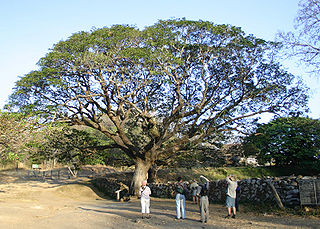
Samanea is a genus of flowering plants in the family Fabaceae. It includes four species of trees native to the tropical Americas, ranging from Belize to Paraguay, and to the Democratic Republic of the Congo in central Africa. Habitats include tropical moist evergreen and seasonally-dry deciduous forest, woodland, and wooded grassland. It belongs to the mimosoid clade of the subfamily Caesalpinioideae. The type species is Samanea saman from South America.

Cinnamomum parthenoxylon is an evergreen tree in the genus Cinnamomum, 10–20 m (33–66 ft) tall. It is native to South and East Asia.

Quercus humboldtii, commonly known as the Andean oak, Colombian oak or roble, is a species of oak found only in Colombia and Panamá. It is named for Alexander von Humboldt.
Anypsipyla is a monotypic snout moth genus described by Harrison Gray Dyar Jr. in 1914. Its only species, Anypsipyla univitella, was described by the same author in the same year. It is found in Central America, South America and has also been recorded from Cuba, Mexico, Jamaica and Florida in the southern United States.

Amphineurion is a genus of plants in the family Apocynaceae, first described as a genus in 1948. It contains only one known species, Amphineurion marginatum, native to Cambodia, S China, India, Indonesia, Laos, Malaysia, Philippines, Thailand and Vietnam.

St David's Anglican Church is a heritage-listed church at 3 Foxton Avenue, Mossman, Shire of Douglas, Queensland, Australia. It was designed by Edward Taffs and Edwin Roy Orchard. It was added to the Queensland Heritage Register on 6 August 2010.

Brosimum utile(Kunth), also called Galactodendron, Pittier is a plant species in the family Moraceae.
Albizia vialeana is a tree species in the Acacia clade of the family Fabaceae, found in parts of Indo-China. Its wood is used for fuel.

A small tree with tortuous twigs, Dillenia pentagyna is a member of the family Dilleniaceae, and is found from Sulawesi to South-Central China to India and Sri Lanka. Material from the tree has some minor uses.
Utania racemosa is a species of flowering plant in the family Gentianaceae. It occurs in Southeast Asia from Sumatera in Indonesia to the Andaman Islands in India. Its wood is used for timber and fuel.

Gaudichaudia is a genus of flowering plants belonging to the family Malpighiaceae.
